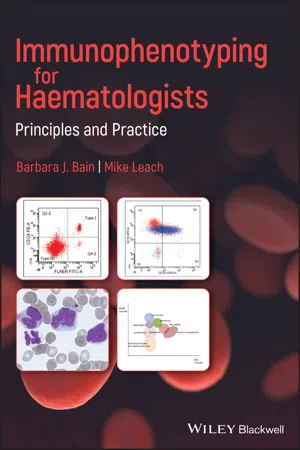
- English
- ePUB (mobile friendly)
- Available on iOS & Android
About this book
Offers clear and concise instruction on running, reporting and interpreting immunophenotyping studies
Written by two well-known haematology educators and experts on the topic, Immunophenotyping for Haematologists contains an introduction to running, reporting and interpreting immunophenotyping studies. The book offers a unique approach to the topic by putting the focus on clinical and laboratory haematologists who are not routinely involved in running and reporting on immunophenotyping studies.
Immunophenotyping using flow cytometry has become the method of choice in identifying and sorting cells within complex populations, for example, the analysis of immune or neoplastic cells in a blood sample. The text reviews the purpose and principles of immunophenotyping and includes an introduction and explanation of the principles and the role of immunophenotyping. The authors examine immunophenotypic characteristics of the disease groups commonly encountered and identify the features that differentiate malignant cells from normal cells. To enhance understanding, the book contains multiple choice and extended matching questions which integrates immunophenotyping with clinicopathological features and the results of other investigations to mimic everyday practice. This important book:
- Provides a concise introduction to running, reporting and interpreting immunophenotyping studies
- Contains a list of all the antibody specificities currently widely used in diagnosis and disease monitoring
- Presents an ideal reference for use in laboratories, including immunophenotyping laboratories
- Aids in the interpretation by covering immunophenotypic characteristics of commonly encountered disease groups
- Identifies the features that differentiate malignant cells from their normal counterparts
Written for haematologists working in both laboratory and clinical haematology, Immunophenotyping for Haematologists is a much-needed reference for understanding and interpreting immunophenotyping studies.
Frequently asked questions
- Essential is ideal for learners and professionals who enjoy exploring a wide range of subjects. Access the Essential Library with 800,000+ trusted titles and best-sellers across business, personal growth, and the humanities. Includes unlimited reading time and Standard Read Aloud voice.
- Complete: Perfect for advanced learners and researchers needing full, unrestricted access. Unlock 1.4M+ books across hundreds of subjects, including academic and specialized titles. The Complete Plan also includes advanced features like Premium Read Aloud and Research Assistant.
Please note we cannot support devices running on iOS 13 and Android 7 or earlier. Learn more about using the app.
Information
Part 1
Purpose and Principles of Immunophenotyping
Flow Cytometric Immunophenotyping

| Fluorescein isothiocyanate (FITC) |
| Phycoerythrin (PE) |
| Allophycocyanine (APC) |
| Peridinin chlorophyll (PerCP) |
| Cyanine 5 (Cy5), cyanine 5.5 (Cy5.5) and cyanine 7 (Cy7) |
| Texas red |
| Pacific blue |
| Brilliant violet |
| Krome orange |
| Alexa Fluor 488 (AF488) |
| Alexa Fluor 647 (AF647) |
| Phycoerythrin‐Texas Red X (ECD) |
| Phycoerythrin‐cyanine 5 (PE‐Cy5) |
| Phycoerythrin‐cyanine 5.5 (PE‐Cy5.5) |
| Phycoerythrin‐cyanine 7 (PE‐Cy7) |
Table of contents
- Cover
- Table of Contents
- Title Page
- Copyright Page
- Preface
- Abbreviations Used in the Book
- Part 1: Purpose and Principles of Immunophenotyping
- Part 2: Immunophenotyping for Haematologists
- Part 3: Immunophenotyping in the Diagnosis and Monitoring of Haematological Neoplasms and Related Conditions with Tables and Figures for Quick Reference
- Part 4: Test Yourself
- Index
- End User License Agreement